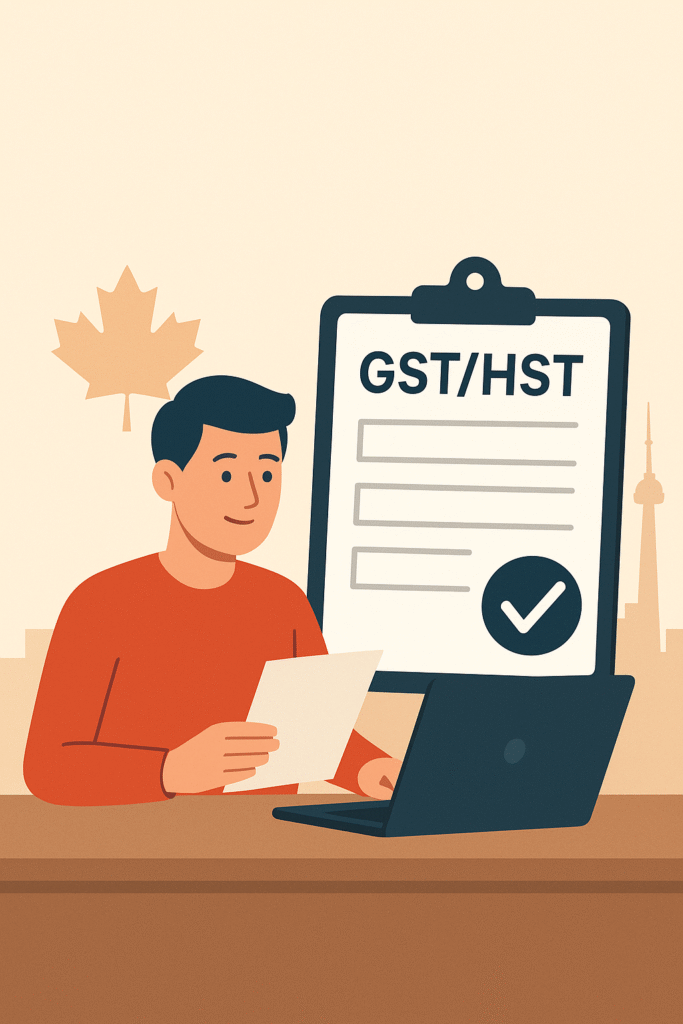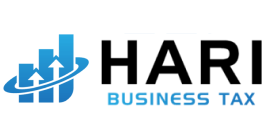How to File a GST/HST Return in Canada
How to file a GST/HST return in Canada is essential knowledge for Canadian businesses aiming to stay compliant with CRA regulations. This comprehensive guide equips you with the tools to navigate obligations, optimize input tax credits, and avoid common pitfalls, ensuring smooth tax compliance, effective tax planning, and minimized audit risks.
Request a Free Consultation
Understanding Your GST/HST Obligations as a Canadian Business

If you run a business in Canada, you should know about your GST/HST obligations. GST stands for Goods and Services Tax, and HST means Harmonized Sales Tax. These are indirect taxes that apply to most goods and services sold here.
What is GST/HST?
The Goods and Services Tax (GST) charges 5% on many goods and services across Canada. Some provinces mix this with their own sales tax, making the Harmonized Sales Tax (HST). The HST rate is usually higher than just GST alone.
Who Needs to Register?
You must register for a GST/HST account with the Canada Revenue Agency (CRA) if your business makes more than $30,000 a year from taxable supplies. This lets you collect tax from your customers for the government. CRA GST/HST Registration
Reporting Periods
Your reporting period shows how often you file your GST/HST returns:
- Annual if your business earns less than $1.5 million.
- Quarterly if it makes between $1.5 million and $6 million.
- Monthly if it earns over $6 million. Knowing this helps you file on time.
Filing Deadlines
Deadlines depend on your reporting period:
- Annual filers must file by June 15 of the next year.
- Quarterly filers file one month after each quarter ends.
- Monthly filers file by the end of the month after their reporting period. Missed deadlines can lead to penalties or interest.
Input Tax Credits (ITCs)
You can claim input tax credits for any GST/HST paid on things you buy for your business. So, if you pay GST or HST on supplies or services, you can get some of that money back when filing—this lowers your costs.
Common Errors to Avoid
Watch out for these mistakes when filing:
- Not keeping clear records of sales and purchases.
- Mixing up exempt supplies with zero-rated supplies.
- Forgetting to claim available ITCs.
- Missing filing deadlines causing fines. Good records make audits easier and reduce errors.
Importance of Accurate Record-Keeping
Keeping good records helps you follow business tax obligations in Canada. It also makes it easier to match sales and purchases when you prepare reports or financial statements.
By keeping up with GST/HST compliance, Canadian businesses can handle their duties smoothly and avoid issues with CRA checks or fines.
For help with filing right and on time so you meet CRA rules, think about contacting Gondaliya CPA!
Registering for a GST/HST Number and Determining Your Reporting Period
Registering for GST/HST
If your business in Canada makes over $30,000 in revenue during four calendar quarters, you have to register for a GST/HST number with the Canada Revenue Agency (CRA). This lets you collect and pay the Goods and Services Tax (GST) or Harmonized Sales Tax (HST) on your sales.
Even if your income is less than $30,000, you can still sign up voluntarily. Doing this lets you claim back input tax credits (ITCs) on things you buy for your business.
Here’s how to register:
- Go to the CRA’s business registration online site.
- Fill in info about your business type and what you do.
- Get your special GST number that links to your account. Register soon so you don’t get in trouble with the law. Remember, after you register, you must file returns regularly—even if you didn’t sell anything that period.
Determining Your Reporting Period
The CRA sets your reporting periods based on how much tax you owe yearly. This decides how often you send GST/HST returns:
- $1,500,000 or less: Annually
- More than $1,500,000: Quarterly
- Large businesses: Monthly Most small businesses send returns every year or every three months. Big businesses with lots of sales send them every month.
When payments are due depends on this:
- Monthly: Due one month after period ends.
- Quarterly: Due one month after each quarter.
- Annually: Due three months after year end. Picking the right reporting period helps keep your cash flow steady and paperwork easy. You can check or change it through CRA My Business Account or call CRA directly.
Keep good records no matter what. Track all sales and buys carefully so your returns match reality.
Knowing how to do GST registration and choosing the right reporting period helps Canadian businesses handle taxes easier and follow the rules well.
Collecting and Calculating Your GST/HST
Knowing how to Collect GST/HST from Customers
You need to charge GST or HST on most taxable goods and services sold in Canada. Here’s the lowdown:
- GST Collection Process: When you sell a product or service that’s taxable, add the right GST or HST rate for your province.
- Business Revenue Threshold: If your total money made goes over $30,000 in four quarters in a row, you have to register for a GST/HST account and start charging tax.
- Taxable Supplies: Most things you sell are taxable unless they are zero-rated (taxed at 0%) or exempt supplies.
- Invoicing Requirements: Your bills must clearly show how much GST/HST you charged. Also, include your business number (BN) from the CRA. Charging the correct tax keeps your records straight when you file your returns.
Calculating GST/HST Owed: Input Tax Credits (ITCs) and Net Tax

To know how much GST/HST you owe, subtract your ITCs from the total tax collected.
- Calculate Total Collected Tax: Add up all the GST/HST you charged customers during the reporting time.
- Input Tax Credits (ITCs): These let you get back tax paid on business stuff like office supplies, equipment, rent, utilities, and professional fees.
- To claim ITCs:
- Keep good receipts showing taxes paid.
- Make sure expenses are tied to business activities.
- Net Tax Calculation: Take away total ITCs from collected taxes. What’s left is what you pay CRA or get back if ITCs are more than what you charged. It’s super important to keep clear sales invoices and purchase receipts to match these numbers right every time.
Follow these steps — charge the right tax from customers and claim legit input tax credits — so your returns match CRA rules. Gondaliya CPA can help businesses file their GST/HST returns on time and reduce audit risks by doing careful calculations and record keeping.
Filing Your GST/HST Return Using CRA My Business Account or Certified Accounting Software
Filing Through CRA My Business Account: A Step-by-Step Guide
The CRA My Business Account is an official online tool for filing your GST/HST return. Here’s how you do it:
- Sign In: Go to the CRA My Business Account website and log in with your info CRA My Business Account.
- Select Tax Type: Pick “GST/HST” from your list of tax accounts.
- Choose Reporting Period: Select your filing period—monthly, quarterly, or yearly—based on what CRA assigned you.
- Enter Sales and Purchases: Put in total sales that have GST/HST and any purchases where you can claim input tax credits (ITCs).
- Calculate Amount Owed or Refund Due: The system figures out how much tax you owe or how much refund you get after ITCs.
- Review & Submit: Check all details carefully before sending it through the CRA tax portal.
- Save Confirmation: Download or print the confirmation to keep as proof.
- Tips to Remember:
- File before the CRA deadline to avoid fees.
- Keep good records of sales, buys, and receipts just in case of audit.
- Filing electronically speeds things up compared to paper returns.
Filing with Certified Accounting Software: A Step-by-Step Guide
Certified accounting software connects directly with CRA. This lets you file GST/HST returns digitally without opening the CRA website every time.
- Follow these steps if you use computerized business accounting software:
- Set Up Your Profile: Make sure your business info in the software matches what CRA has on file.
- Record Transactions Accurately: Enter all sales invoices and purchase receipts for each reporting period right away.
- Generate Return Data Automatically: Most digital filing tools pull together numbers like taxable sales, exempt items, ITCs claimed, and more from your data.
- Review Draft Return Carefully: Compare reports with your actual records to catch mistakes before filing.
- File Electronically Through Software Interface: Submit directly from the program. Many give instant confirmation when CRA accepts it.
- Why Use Certified Software?
- Cuts down on manual typing errors by automating tasks
- Links transactions directly for easier record keeping
- Sends reminders about when returns are due
- Creates a clear audit trail to boost compliance Keeping clean records and matching sales with purchases makes filing GST/HST smoother. Whether you use CRA My Business Account or certified accounting software, it helps avoid mistakes and late filings.
If you’re unsure about filing GST HST returns or want help staying on time and accurate with Canada Revenue Agency rules, professional help is handy.
Gondaliya CPA helps businesses handle their GST/HST returns correctly and promptly — keeping things right with CRA rules every step of the way.
Frequently Asked Questions About Filing Your GST/HST Return
- Q1: What are common mistakes when filing a GST/HST return?
- Mistakes include picking wrong reporting periods, messing up input tax credits (ITCs), forgetting zero-rated sales, and missing deadlines that cause penalties.
- Q2: How often do I need to file my GST/HST returns?
- Your filing schedule depends on your annual income. It can be monthly, quarterly, or yearly as CRA decides when you register.
- Q3: Can I change my method of filing later?
- Yes! You can switch between using the online portal via My Business Account or different certified accounting software whenever you want.
By following these steps, you can simplify tax season, reduce hassle, and save time.
Need expert help? Contact Gondaliya CPA today for support in handling timely and correct gst/hst return filings made just for Canadian businesses’ needs!
Important Deadlines, Common Errors, and Accurate Record-Keeping for GST/HST Filing
GST/HST Filing Deadlines and Penalties for Late Submissions
The Canada Revenue Agency (CRA) sets your filing deadlines based on your reporting period. Here’s how they break down:
- Monthly filers: You must file one month after each month ends.
- Quarterly filers: File one month after the quarter ends.
- Annual filers: File three months after your fiscal year ends. If you miss these dates, you get a penalty called a GST penalty. It starts at 1% of what you owe plus 0.25% for each day you’re late. The max penalty is 12%. Also, interest builds up on what you haven’t paid from the deadline until it’s all paid.
To avoid problems:
- Put all tax payment deadlines in your calendar.
- File returns even if you don’t owe anything. This stops late-filing penalties. Knowing your exact deadline lowers stress and keeps your business safe with CRA.
Common GST/HST Filing Errors to Avoid
Many businesses make simple errors that cause audit risks. Watch out for these common mistakes:
- Reporting wrong sales or taxable amounts
- Claiming input tax credits (ITCs) without proof
- Mixing personal and business expenses
- Forgetting some transactions or entering them twice
- Using wrong reporting periods or rates These slip-ups can cause CRA audits or reassessments. To keep audit risks low:
- Check your numbers before filing.
- Keep clear proof for every claim you make. Avoiding these mistakes means fewer headaches and smoother filings.
Importance of Accurate Record-Keeping and Reconciling Sales and Purchases
Good record‑keeping matters a lot when filing GST/HST returns. Keep detailed books with all sales invoices, purchase receipts, credit notes, and other papers.
Check sales and purchases often by matching invoices with bank statements or software reports. This helps catch missing info early so you can fix it before filing.
Here are good bookkeeping tips:
- Keep original receipts organized by date
- Record every sale that has GST/HST correctly
- Track input tax credits carefully with proof
- Update records right after transactions happen Good records help support correct ITC claims and cut down errors that slow things during CRA reviews.
By knowing important deadlines, skipping common errors, and keeping precise records through regular checks, Canadian businesses can file their GST/HST returns on time. This helps avoid costly penalties or audits.
For expert help to file on time and meet CRA rules—think about working with Gondaliya CPA’s team today.
Ensuring CRA Compliance and Minimizing Audit Risks with Gondaliya CPA
Understanding GST/HST Compliance and Audit Risks
The CRA checks many businesses’ GST/HST returns to make sure they are correct. If you miss something or make errors, the CRA might audit your records. Audits can lead to extra fees or penalties. Some common triggers include:
- Filing late or not filing at all
- Reporting sales or input tax credits (ITCs) wrong
- Not keeping enough records Being careful about compliance lowers these chances a lot.
Key Steps to Avoid Penalties for Late Filing
If you file late, the CRA hits you with a penalty. It starts at 1% of what you owe plus 0.25% more for each month late, up to a year. To avoid that:
- File your GST/HST return on time based on your schedule (monthly, quarterly, or yearly).
- Use reminders or software alerts so you don’t forget deadlines.
- Double-check sales and purchase info before filing. Filing on time helps keep penalties away and keeps your record clean with CRA.
Common Errors That Increase Audit Risk
Watch out for these mistakes when filing your GST/HST return:
- Claiming ITCs without the right papers
- Mixing personal and business expenses
- Doing math wrong on taxable amounts
- Forgetting things like bad debts or returns Good record keeping can help stop these errors.
Tax Documentation Requirements: What You Need to Keep
The CRA wants businesses to keep records for at least six years after the tax year ends. You should have:
- Document Type: Why You Need It
- Sales invoices: To prove income reported
- Purchase receipts: To back up claimed ITCs
- Bank statements: To match cash flow
- Contracts & agreements: To confirm deal terms Keeping files neat makes audits easier and helps with accurate filing.
Using a Tax Compliance Checklist for Your Business GST Account
A checklist makes sure you don’t miss anything when managing Canadian GST/HST compliance:
- Check if your registration fits your current business work.
- Review all sales and purchases every month.
- Figure out net tax owing right each period.
- File returns online via CRA My Business Account or approved software.
- Pay what you owe quickly.
- Keep all important papers safe.
- Meet with a tax expert now and then if needed. Using this list keeps you on track with CRA rules all year.
Additional FAQs on Filing GST/HST Return in Canada
What is the difference between zero-rated supplies and exempt supplies?
Zero-rated supplies are taxable at 0%, meaning you charge no GST/HST but can claim ITCs. Exempt supplies are not taxed, and you cannot claim ITCs on them.
Can small businesses use the GST quick method for filing?
Yes, eligible small businesses with taxable sales under $400,000 can use the GST quick method to simplify calculating GST owed.
How do I reconcile sales and purchases for accurate GST/HST returns?
Match sales invoices with purchase receipts regularly. This ensures your reported figures and ITC claims are correct before filing.
Is voluntary GST registration beneficial for small businesses?
Yes, it lets you claim input tax credits even if you earn under $30,000, helping reduce costs on business purchases.
What types of expenses qualify as eligible for input tax credits (ITCs)?
Expenses must be related to your business activities and include items like office supplies, rent, utilities, and professional fees with proper receipts.
How can computerized accounting software help with GST compliance?
It automates calculations, keeps an audit trail, sends filing reminders, and directly files returns through CRA’s online portal.
What penalties apply if I miss the GST payment deadline?
CRA charges a penalty starting at 1% of the amount owing plus 0.25% for each additional month late, up to 12%, plus interest on unpaid amounts.
Key Points on GST/HST Compliance for Canadian Businesses
- Use certified accounting software to simplify digital tax filing and improve reporting accuracy.
- File GST/HST returns electronically via CRA tax portal or integrated business accounting software.
- Keep thorough bookkeeping records including sales invoice records and purchase receipts.
- Understand the tax period selection for monthly, quarterly, or annual filing frequency.
- Reconcile financial transactions often to avoid discrepancies in your business GST/HST filing.
- Track eligible expenses for ITC claims carefully with supporting documentation.
- Maintain an audit trail documentation to prepare well for any CRA audits or reviews.
- Follow a tax compliance checklist covering registration status, record review, filing, payment deadlines, and document retention.
- Consider professional tax expert consultation to navigate complex rules and minimize audit risks.
- Ensure timely GST remittance to avoid penalties for late filing or missed payments.
How Gondaliya CPA Assists With Timely and Accurate Filings
Gondaliya CPA helps you file GST/HST returns correctly through CRA My Business Account or trusted software tools. We can:
- Check your numbers for mistakes before sending them in
- Prepare complete records ready if an audit happens
- Give advice on ways to cut down common errors
- Remind you about deadlines so nothing gets missed
- Offer help to lower chances of audits Working with pros means less worry about taxes and fines.
Staying aware of the GST audit process, penalties, required documents, and following a clear plan—plus support from Gondaliya CPA—helps Canadian businesses file right on time. This way, they avoid big fines and focus on growing their business.
Need help managing your business’s GST/HST filings?
Contact Gondaliya CPA for personalized service in managing your Canadian GST/HST return filing needs efficiently and correctly.

Sharad Gondaliya CPA Canada and CPA USA having 14 Years+ experience of Accounting, Tax, Payroll of Corporate Small Businesses as Tax Accountant. He is fully certified CPA Ontario and CPA USA. He is well known amoung Corporate Small Businesses for Tax Planning, efficient Tax solutions and for Affordable CPA services, He is Principal (Director) at Gondaliya CPA – Affordable CPA in Canada.




